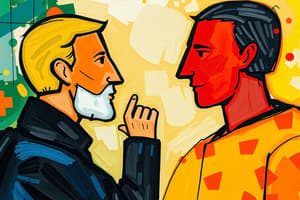Podcast
Questions and Answers
What is a key characteristic of transformational leadership?
What is a key characteristic of transformational leadership?
- Inspiring change through vision and influence (correct)
- Maintaining strict control over followers
- Focusing on individual follower's needs
- Emphasizing routine transactions for performance
Which barrier to effective communication is caused by differing cultural backgrounds?
Which barrier to effective communication is caused by differing cultural backgrounds?
- Physical barriers like noise
- Nonverbal barriers involving misinterpretation of gestures
- Personal barriers such as lack of trust
- Cross-cultural barriers leading to misunderstandings (correct)
Which communication channel is considered rich and suitable for complex messages?
Which communication channel is considered rich and suitable for complex messages?
- Social media posts
- Face-to-face meetings (correct)
- Memos
What is a primary emphasis of servant leadership?
What is a primary emphasis of servant leadership?
What is one technique for improving communication skills effectively?
What is one technique for improving communication skills effectively?
What is an example of a rich communication channel?
What is an example of a rich communication channel?
How can a manager overcome cross-cultural communication barriers?
How can a manager overcome cross-cultural communication barriers?
Which motivational theory emphasizes the importance of autonomy, competence, and relatedness?
Which motivational theory emphasizes the importance of autonomy, competence, and relatedness?
What is a common misconception about job design in a traditional approach?
What is a common misconception about job design in a traditional approach?
Which factor does Expectancy Theory focus on in relation to motivation?
Which factor does Expectancy Theory focus on in relation to motivation?
What does Herzberg's Two-Factor Theory differentiate between?
What does Herzberg's Two-Factor Theory differentiate between?
What might be a nonverbal indicator of disengagement in a meeting?
What might be a nonverbal indicator of disengagement in a meeting?
Which of the following is a key aspect of empathy in a managerial context?
Which of the following is a key aspect of empathy in a managerial context?
What is the primary focus during the 'Storming' stage of team development?
What is the primary focus during the 'Storming' stage of team development?
Which conflict resolution technique involves yielding to the other party's demands?
Which conflict resolution technique involves yielding to the other party's demands?
What distinguishes 'Trait Theories' of leadership from 'Behavioral Theories'?
What distinguishes 'Trait Theories' of leadership from 'Behavioral Theories'?
Which of the following is NOT a type of conflict mentioned in conflict management?
Which of the following is NOT a type of conflict mentioned in conflict management?
Intrinsic rewards primarily focus on which aspect of employee satisfaction?
Intrinsic rewards primarily focus on which aspect of employee satisfaction?
What is the main goal of the 'Norming' stage in Tuckman's model of team development?
What is the main goal of the 'Norming' stage in Tuckman's model of team development?
What characteristic is commonly associated with 'Situational Leadership'?
What characteristic is commonly associated with 'Situational Leadership'?
Which of the following statements accurately describes 'Dysfunctional Conflict'?
Which of the following statements accurately describes 'Dysfunctional Conflict'?
Flashcards
Communication Process
Communication Process
The steps involved in sending and receiving a message, including encoding, medium, decoding, and potential noise.
Rich Channels
Rich Channels
Communication methods that allow for more nuanced and detailed information exchange (e.g., face-to-face).
Lean Channels
Lean Channels
Communication methods that provide less detail and context (e.g., email).
Maslow's Hierarchy of Needs
Maslow's Hierarchy of Needs
Signup and view all the flashcards
Herzberg's Two-Factor Theory
Herzberg's Two-Factor Theory
Signup and view all the flashcards
Equity Theory
Equity Theory
Signup and view all the flashcards
Expectancy Theory
Expectancy Theory
Signup and view all the flashcards
Goal-setting Theory
Goal-setting Theory
Signup and view all the flashcards
Job Enrichment
Job Enrichment
Signup and view all the flashcards
Functional Conflict
Functional Conflict
Signup and view all the flashcards
Tuckman's Model
Tuckman's Model
Signup and view all the flashcards
Team vs. Group
Team vs. Group
Signup and view all the flashcards
Leadership vs. Management
Leadership vs. Management
Signup and view all the flashcards
Situational Leadership
Situational Leadership
Signup and view all the flashcards
Dysfunctional Conflict
Dysfunctional Conflict
Signup and view all the flashcards
Performance-based pay
Performance-based pay
Signup and view all the flashcards
Transformational Leadership
Transformational Leadership
Signup and view all the flashcards
Servant Leadership
Servant Leadership
Signup and view all the flashcards
Ethical Leadership
Ethical Leadership
Signup and view all the flashcards
Rich Communication Channels
Rich Communication Channels
Signup and view all the flashcards
Lean Communication Channels
Lean Communication Channels
Signup and view all the flashcards




